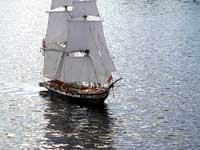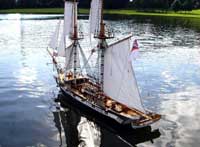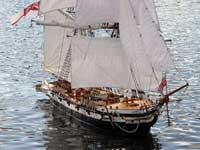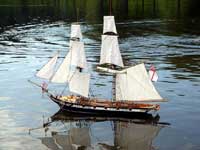|
A Square Rigger on a British Pond |
|
by Mark Steele - Auckland, New Zealand
Photos by Brian Clark - Newcastle on Tyne, UK |
Brian Clark of Newcastle on Tyne in the United Kingdom is one of these ship modellers blessed not only with immense skill, but also endowed with an abundance of patience, together enabling him to produce a wonderful replica of a 12 gun Man-o'war of the 1840's.
Because he wanted it to be a fully working sailing model the scale had to be both practical and as large as he coud make it and still enable it to be transportable - as big as his little car trailer could carry. Having bought plans from a Glasgow plans service in Scotland, the dream started to take shape at a scale of half inch to the foot or 1/24th scale.
 |
a wonderful replica of a 12 gun Man-o'war of the 1840's.
(click images for larger views) |
|
This worked out at a hull length of 63" with a total length including the bowsprit of 84", the hull a scratchbuilt fibreglass shell with a planked deck. HMS Killingworth is of a class but not of a particular vessel, named by Brian after his local sailing lake. A number oif these ships remained in commission in Britain's Royal Navy and were operational well into the 20th Century as seagoing training ships, Nautilus, Seaflower and Liberty among them.
| HMS Killingworth is of a class but not of a particular vessel, named by Brian after his local sailing lake. |

|
|
As Publisher of my own little model sailboat magazine, whereas just a few years ago there was little activity that I was aware of in the choice of square-rigged model ships that could actually be sailed, over the last three years there has been increased awareness and interest that has led to several ship modellers tackling such products. Of course there was always interest in producing such models for static display purposes, but to sail them on the pond and make them as working models, probably because of the large size required was another matter.
Brian Clark is a very innovative person and the guns aboard HMS Killingworth are fired by 12 volts being put through fine cables weakened in the middle of the charge, the charges all hand-rolled and using cigarette paper they do smoke. Clever ? I think so. The anchor winch is a battery screwdriver, the anchors themselves, and the guns cast in phosphor bronze and blackened and all cannon trucks are wired for electrical firing using Pyrodex for powder, with each gun able to be fired individually.
 |
The guns aboard HMS Killingworth are fired by 12 volts being put through fine cables weakened in the middle of the charge.
|
|
A modeller knows well that he or she must always `think ahead', and in order to facilitate easy of transport, Brian hinged both masts above the fighting tops. By removing brass pins, the masts can be folded forward and locked in place.
I first heard about this model from MODEL BOAT MAYHEM - a wonderfully comprehensive website in Britain enabling me to make contact with the builder who finally launched the boat in August 2005 after three years and three months spent building it. Later Brian sent me a selection of wonderful photos and Duckworks viewers are able to admire these photos of the completed radio controlled ship under sail.
| By removing brass pins, the masts can be folded forward and locked in place. |

|
|
Of course a model of this magnitude is not for either the faint-hearted or the impatient and is one where time at ones disposal is paramount. It is not a model that has to be finished by a set time!
When it is finally completed however, a model of this kind is guaranteed to be a magnificent sight on the water of ones local pond or lake, one that will attract immense interest from passers by, one that that will stand as testimony to the skill of the modelmaker responsible for its creation.
 |
Of course a model of this magnitude is not for either the faint-hearted or the impatient.
|
|
I for one stand in awe of his abilities.

More articles about models:

|